The greatest mystery of modern radio astronomy comes down to just three letters: FRB. They stand for fast radio bursts, signals that continue to defy explanation. As the name implies, these bursts of radio waves last just a millisecond or two. They’re also incredibly strong, among the brightest radio sources in the sky. That’s despite traveling an incredible distance, up to billions of light-years. Do the math, and it’s clear how powerful these things are. One FRB can easily broadcast more energy in a moment than the sun produces in a day.
Visible light is only a part of the electromagnetic spectrum, but if your eyes could see radio waves, you’d probably spot FRBs in the sky all the time — thousands of them a day, from all directions. Despite their prevalence, though, no one had ever detected one — or even heard of one — as little as 20 years ago. Today, it remains unclear what FRBs really are. But thanks to improved technology and some lucky breaks, astronomers are finally on the verge of finding out.
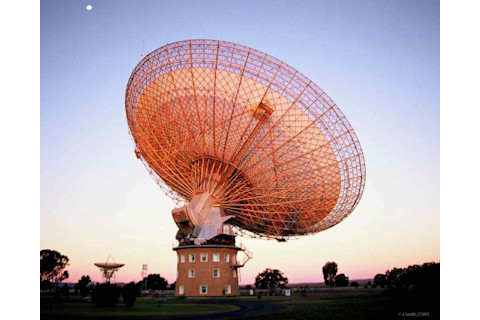
The Parkes Observatory in Australia detected the first known fast radio burst, and remains one of astronomy's best tools to find the elusive signals. (Credit: J. Smith/CISRO)
J. Smith/CISRO
Burst From the Heavens
Nobody was looking for FRBs. In fact, the first one was discovered almost by accident in 2007. Undergraduate student David Narkevic had been working for radio astronomer Duncan Lorimer at West Virginia University, looking through old data and hunting for the ghosts of dead stars.
When big enough stars die in a fiery supernova, they can leave behind corpses — cores made entirely of neutrons, called (naturally) neutron stars. These can emit beams of radiation and spin several times a second, so when the beams sweep past Earth, they appear as pulses, akin to a cosmic lighthouse blinking in the distance. It was these “pulsars” that Narkevic sought. He was combing through observations from the Parkes Observatory in Australia for pulses from two satellite galaxies, called the Magellanic Clouds, that orbit our Milky Way.
But one cold winter day, a strange burst of radiation in that old data — definitely not a pulsar — caught Narkevic’s attention, and he told his boss that he thought he’d found . . . something. It was a single, bright pulse, but it did not appear to come from the Magellanic Clouds. Instead, the origin was an area of deep space well beyond our galactic neighborhood. “I was stunned,” recalls Lorimer, “and didn’t know what to make of it.” He knew it was unlike anything he’d seen before, and he published the findings later that year, eventually dubbing the event an FRB.
At first, no one else knew what to make of it, either. Many astronomers were skeptical, speculating that mundane sources such as lightning strikes or even microwave ovens created the signal. “Even my own wife [radio astronomer Maura McLaughlin] argued the burst wasn’t real!” Lorimer recalls.
FRB seekers don’t have it easy: The signals are very brief, the sky is very big and many radio telescopes, like Parkes, can observe only a tiny part of the sky at a time. Astronomers found many false positives, too, which didn’t help. Eventually though, verified FRB signals from radio telescopes around the globe began to pile up, satisfying most skeptics. To date, researchers have spotted 52.
Astronomers were finally satisfied that they really had a brand-new class of radio signals on their hands. But they knew almost nothing about them.
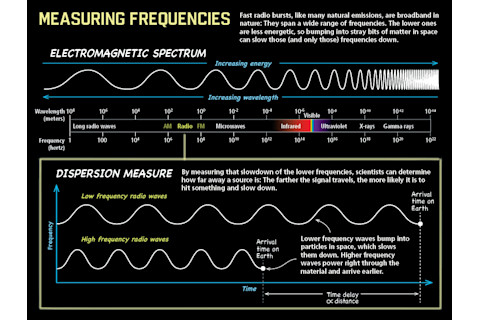
(Credit: Roen Kelly/Discover)
Roen Kelly/Discover
Ragged Radio Waves
One of the few things astronomers did know about FRBs was their distant origin, with each one coming from deep space. How could they tell? The information is actually hidden within the signal itself.
Most naturally generated radio signals are broadband, meaning they span a range of frequencies, unlike a signal from your local FM radio station, which has one specific frequency. (We use narrow-band signals on Earth to maximize the available spectrum, which we all share, but nature is not so considerate.)
Look closely at any given astronomical radio signal, and you’ll see that its lower frequencies arrive slightly later than its higher ones. This is because while space is a better vacuum than any on Earth, it’s not a perfect one, and a stray particle still lurks here and there. Those stray bits of stuff interact with radio signals and slow the lower, weaker parts down, while the more energetic higher frequencies don’t interact as much, and can zoom past. The greater the distance the signal has traveled, the greater the delay of the lower frequencies usually is. Astronomers call this characteristic of a signal its dispersion measure (DM).
If one of these pulses were starting out in our own galaxy, we might get a DM of around 30. The Magellanic Clouds are over 200. The oldest detected FRB, found later in archival data preceding Lorimer’s discovery, had a DM of 790, meaning it came from billions of light years away.
That distance tells astronomers a lot about the provenance of FRBs: To see such a brief signal, so bright, from so far away, would require an extremely energetic source. The trouble is, even now, no one knows what such an event might be. “None of the models exist without major problems,” says Victoria Kaspi, a radio astronomer at McGill University.
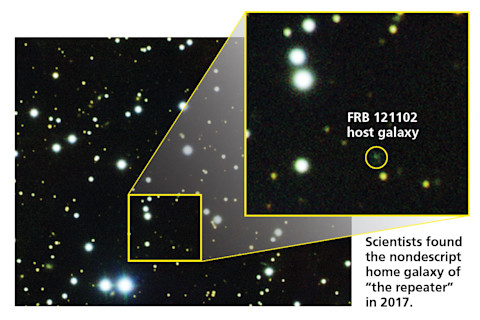
(Images, credit: Gemini Observatory/AURA/NRC/NSF/NRAO)
The Repeater Beckons
The first major FRB breakthrough came with the discovery of a special one called FRB 121102. (FRBs are named by the date they were discovered, this one on Nov. 2, 2012.) It stands out because unlike all other known FRBs — which only burst once and are never seen again, despite extensive follow-up observations — FRB 121102 repeats. Sometimes “the repeater,” as it’s known, will be quiet for weeks or months at a time, and then sometimes it will burst several times a day. There is no pattern.
But the repetitive, erratic signals have allowed patient astronomers to learn more about this FRB than any other. Knowing generally where to look in the sky for repeat performances has allowed them to pin down its coordinates more precisely than they can with one-off FRBs. This level of precision is what finally allowed astronomers to follow up with giant optical telescopes, like the Gemini Observatory in Hawaii and the Hubble Space Telescope, and see where the signal was coming from.
These observations have revealed the repeater’s home to be a nondescript dwarf galaxy 3 billion light-years away. It’s about the size of the Large Magellanic Cloud, some 10 percent as big as the Milky Way. That alone was surprising: Astronomers anticipated something like an FRB would come from a large, active galaxy with a bright supermassive black hole or active star formation, not this cosmic pipsqueak.
In 2018, researchers went even deeper. By carefully analyzing the tremendous twisting of the repeater’s radio waves, called the signal’s polarization, they learned its home environment is an unusual one. “I think a neutron star is involved in creating the bursts, in an extreme environment,” says the study’s lead author, Daniele Michilli at McGill University.
The signals could originate from a specific type of neutron star known as a magnetar, which has extraordinarily strong magnetic fields. They’re so powerful that they could kill you from thousands of miles away by compressing the electron clouds in your atoms. A magnetar’s powerful signals, warped by an extreme environment such as the area near a supermassive black hole, may explain the FRB’s strong polarization. Or, it could be something else entirely — the repeater is still one of a kind, so it’s hard to draw any broad conclusions.
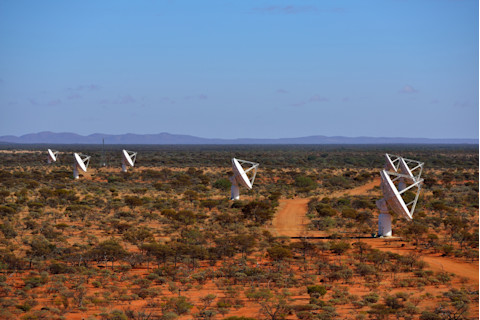
The Australian Square Kilometer Array Pathfinder consists of 36 separate dish antennas spread across a wide area, working together as one. It can detect millions of other radio signals in a matter of days, and found 20 FRBs in 2018, almost doubling the current total. (Credit: CSIRO)
CSIRO
Avalanche of Data
“Finding more FRBs is the most urgent goal at the moment,” says Emily Petroff, a radio astronomer at the University of Amsterdam. “We just don’t have enough information on where they’re coming from.”
Petroff discovered some of the first FRBs, back when people weren’t certain if they were real, and she helped legitimize the field by building the first comprehensive catalog of the signals. She believes that in order to solve the mystery of FRB origins, astronomers must first find hundreds of examples and then look for patterns and standouts in that large population.
“Currently, each FRB is like a unique snowflake where we admire each one’s individual details,” Petroff says. “What we need next is a snowbank.”
The first snows are already falling, with a radio telescope in Canada becoming an FRB-hunting machine. The Canadian Hydrogen Intensity Mapping Experiment (CHIME) has, as its name implies, the primary goal of mapping hydrogen clouds in galaxies. But since the radio telescope looks at a lot of the sky at once, FRBs should also pop up during the mapping.
Further, the stationary CHIME will look at the same patch of sky once a day as it drifts overhead, making it ideal to spot repeating FRBs. Should one turn up within CHIME’s field of view, the experiment can check in on it every day automatically, looking for new bursts. Last July, the science team spotted its first FRB, and it expects to find several repeating FRBs — if more are out there.
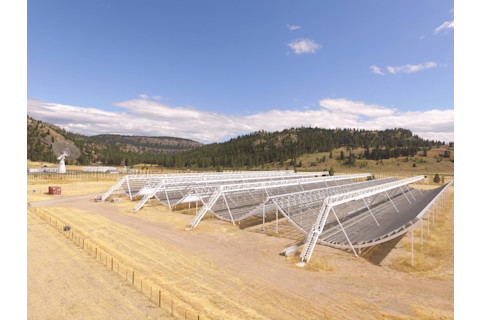
The Canadian Hydrogen Intensity Mapping Experiment telescope can scan the skies quickly and has no moving parts. Its unique design makes it an ideal instrument to detect transient radio emissions such as FRBs. (Credit: National Research Council of Canada)
National Research Council of Canada
Flashes of Light
Already, that growing snowbank of data has produced some surprises. The latest twist in the FRB story came from a project at the Australian Square Kilometer Array Pathfinder (ASKAP) radio telescope in October, when astronomers announced the discovery of 20 bright FRBs, nearly doubling the total number known at the time.
“We chose 50 [locations] all over the sky very carefully and hammered them for hundreds of hours of observing to see if we could find another repeater,” says Keith Bannister, one of the scientists involved in the survey. None of the 20 repeated — but that wasn’t the big deal.
When the ASKAP team compared its FRBs with others from Parkes Observatory, it found an interesting connection. The ASKAP FRBs were all brighter but had lower DMs, meaning they were all closer as well. This makes sense: On a foggy night, a flashlight that’s closer appears brighter. You could even measure how far away it is by studying its relative brightness. ASKAP’s data showed that FRBs follow the same pattern.
But imagine if you saw a flashlight at a distance you knew precisely, but it appeared much fainter than it should have. If nothing else had changed, you’d wonder if you were looking at a second, different flashlight. The repeater, FRB 121102, is that second flashlight: While all non-repeating FRBs appear to follow the same pattern in DM and brightness that ASKAP established, the repeater appears far fainter than expected at its DM.
This has left many astronomers scratching their heads. Could different phenomena create one-off and repeating FRBs?
“Whether all FRBs are the same is really an open question,” says Bannister. “I try not to be opinionated as a scientist; I like to just go off and measure. But . . . my gut feeling is we end up finding two versions [of FRBs].” It wouldn’t be the first time astronomers turned one discovery into two.
Out of One, Many
Astronomers may end up finding out FRBs come in different flavors, with different phenomena causing different kinds of bursts — and there is precedent for this in astronomy.
In 1973, the U.S. military declassified the existence of gamma-ray bursts (GRBs), first detected in the 1960s by military satellites designed to find gamma radiation from nuclear weapons tests. By 1994, at least 118 models of GRBs were published, with every new discovery ruling out a handful.
It turned out GRBs actually come in two major categories (plus a few rarer ones): About 90 percent of detections are so-called “long GRBs,” which arise when a supermassive star collapses into a supernova. Most of the rest are “short GRBs,” whose origins, involving the merger of two neutron stars, were confirmed only in 2017.
Similarly, supernovas themselves turn out to have multiple origins. The most common supernova occurs when an extra-large star runs out of fuel and dies in a titanic explosion, leaving behind a neutron star or black hole. However, a smaller subset of supernovas occurs when a white dwarf — the glowing ember left behind when a regular-sized star dies — reignites and rips apart. Astronomers believe this happens when the white dwarf gains mass, either by siphoning it from a companion star or merging with another white dwarf, or perhaps both. The exact circumstances of what causes these types of supernovas remain a mystery — for now.
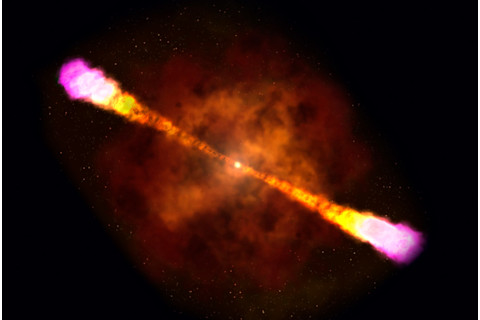
Artist’s rendering of a gamma-ray burst. (Credit: NASA’S Goddard Spaceflight Center)
NASA’S Goddard Spaceflight Center
Mysterious Messengers
For every answer about FRBs, the data have provided us with several new questions. Do they all repeat? Is there any pattern in the repetition? Are they all even the same type of phenomenon? “There are more theories than bursts,” Lorimer would quip before the recent flood of FRBs, “and nobody knows for sure.”
Kaspi goes even further. “I’m very puzzled by it,” she says, “and I think there’s a lot of possibility, including things that we can’t imagine right now.” Perhaps young neutron stars are more energetic than anyone expects, or maybe FRBs involve physics we don’t understand, or the bursts could require conditions so rare that it turns out nothing in our galactic neighborhood sets them off. Extraordinary claims, of course, require extraordinary evidence, but FRBs definitely fit that bill.
Even better, FRB signals, regardless of what causes them, may be useful in deciphering mysteries about the universe, thanks to the vast distances they travel. New research suggests the bursts could be a new way to learn about the relatively unstudied and sparse material that lies between galaxies by studying the dispersion measures they cause. Researchers may even detect the existence of magnetic fields out there, a phenomenon about which we currently know almost nothing.
Despite all the lingering questions, at least one thing is clear: The FRB era of astronomy has arrived.
Yvette Cendes is a radio astronomer at the Dunlap Institute for Astronomy and Astrophysics, University of Toronto. Visit her website at www.whereisyvette.com. This article originally appeared in print as "WTH are FRBs?"















